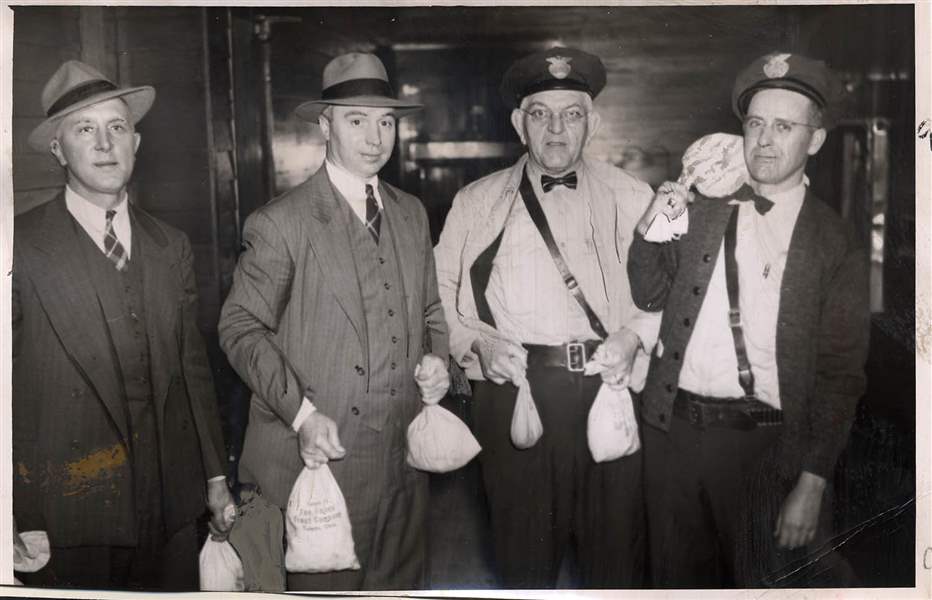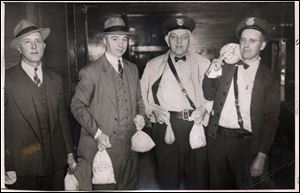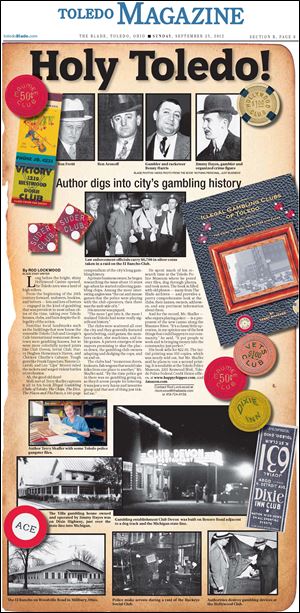
TOLEDO MAGAZINE
Holy Toledo!: Author digs into city’s gambling history
9/23/2012
Law enforcement officials carry $6,700 in silver coans taken in a raid on the El Rancho Club.
The Blade
Buy This Image

Law enforcement officials carry $6,700 in silver coans taken in a raid on the El Rancho Club.

Long before the bright, shiny Hollywood Casino opened, the Toledo area was a land of high rollers
From the beginning of the 20th century forward, mobsters, bookies, and bettors — lots and lots of bettors — engaged in the kind of gambling that was prevalent in most urban cities of the time, taking over Toledo houses, clubs, and bars despite the illegality of the action.
Familiar local landmarks such as the buildings that house the venerable Toledo Club and Georgio’s Cafe International restaurant downtown were gambling houses, but so were more colorfully named joints like Club Devon, Jovial Club, Harry Hughes Horseman’s Haven, and Chicken Charlie’s Cabaret. Tough guys like Frank Enpactato, Yonnie Licavoli, and Leo "Lips" Moceri ruled the rackets and waged violent battles of retribution.
Ah, the good old days?
Well, sort of. Terry Shaffer captures it all in his book Illegal Gambling Clubs of Toledo: The Chips, The Dice, The Places and The Faces, a 146-page compendium of the city’s long gambling history.
A private business owner, he began researching the issue about 15 years ago when he started collecting gambling chips. Among the more interesting angles was "the cat and mouse games that the police were playing with the club operators, then there was the mob side of it."
His interest was piqued.
"The more I got into it, the more I realized Toledo had some really significant history."
The clubs were scattered all over the city and they generally featured sports betting, card games, the numbers racket, slot machines, and table games. A pattern emerges of new mayors promising to shut the places down, the gambling club owners adapting and dodging the cops, and on and on.
The clubs had "numerous doors, lookouts, fish wagons that would take folks from one place to another," Mr. Shaffer said. "By the time police got in there was no gambling going on, so they’d arrest people for loitering. It was just a very funny and inventive group and that sort of thing just tickled me."
He spent much of his research time at the Toledo Police Museum where he pored over files, dug through photos, and took notes. The book is filled with old photos — many from The Blade archives — and provides a pretty comprehensive look at the clubs, their names, owners, addresses, and any pertinent information about them.
And for the record, Mr. Shaffer — who enjoys playing poker — is a proponent of the new casino along the Maumee River.
"It’s a classy little operation, in my opinion one of the best things that could happen to our community," he said. "It put people to work and is bringing money into the community; just perfect."
His book sells for $22.95. The initial printing was 350 copies, which was nearly sold out, but Mr. Shaffer said he plans to run a second printing. It is available at the Toledo Police Museum, 2201 Kenwood Blvd., Toledo Police Federal Credit Union offices at www.happychipper.com, and Amazon.com.
Contact Rod Lockwood at: rlockwood@theblade.com or 419-724-6159.